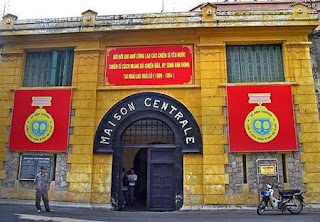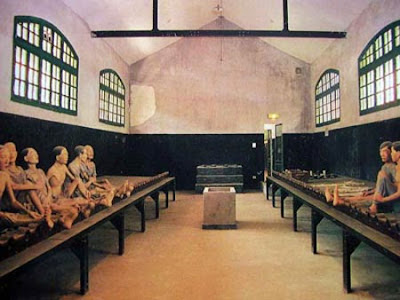 |
| Hoa Lo Prison In Hanoi |
The Hoa Lo Prison (Vietnamese: Hoa Lo, commonly translated as "fiery furnace", actually means "stove". The name originated from the street name "Pho Hoa Lo" due to the concentration of stores selling wood stoves and coal-fire stoves along the street from pre-colonial times)
Hoa Lo Prison Hanoi
Later known to American prisoners of war as the Hanoi Hilton, was a prison used by the French colonists in Vietnam for political prisoners and later by North Vietnam for prisoners of war during the Vietnam War. The prison was built in Hanoi by the French in 1901, when Vietnam was still part of French Indochina to hold Vietnamese prisoners, particularly political prisoners agitating for independence who were often subject to torture and execution. The French called the prison Maison Centrale - a usual term to denote prisons in France.
U.S. POWs endured conditions that were miserable, and were fed food so bad that the prison was sarcastically nicknamed the "Hanoi Hilton," in reference to the well-known Hilton Hotel chain.
The Hanoi Hilton was merely one site used by the North Vietnamese Army to torture and interrogate captured servicemen, mostly American pilots shot down during bombing raids. Communist propagandists countered by stating that prisoners were treated with decency and that the prison was no worse than prisons for POWs and political prisoners in South Vietnam such as the one on Con Son Island.
U.S. POWs endured conditions that were miserable, and were fed food so bad that the prison was sarcastically nicknamed the "Hanoi Hilton," in reference to the well-known Hilton Hotel chain.
The Hanoi Hilton was merely one site used by the North Vietnamese Army to torture and interrogate captured servicemen, mostly American pilots shot down during bombing raids. Communist propagandists countered by stating that prisoners were treated with decency and that the prison was no worse than prisons for POWs and political prisoners in South Vietnam such as the one on Con Son Island.
When prisoners of war began to be released from this and other North Vietnamese prisons in the late 1960s and early 1970s, their testimonies revealed widespread and systematic abuse of prisoners of war. Initially this information was suppressed by American authorities for fear that conditions might worsen for the those remaining in North Vietnamese custody.
After the Paris Peace Accords implementation, neither the United States nor its allies ever formally charged North Vietnam with the war crimes revealed to have been committed there. Extradition of North Vietnamese officials who had violated the Geneva Convention was not a condition of the U.S. withdrawal and ultimate abandonment of the South Vietnam government. The present government of Vietnam firmly holds to the view that the Hanoi Hilton was a prison for criminals, not POWs, and that those held in the Hanoi Hilton were "pirates" and "bandits" who had attacked Vietnam without authority.
Vice Presidential candidate James Stockdale and decorated U.S. Air Force pilot Bud Day were held as a prisoners at the Hanoi Hilton, as was Senator John McCain, who spent parts of his five and a half years as a POW there. Actress Jane Fonda visited the Hanoi Hilton as part of an anti-war publicity trip. Brigadier General Robbie Risner was the senior ranking POW, responsible for maintaining chain of command among his fellow prisoners, from 1965 to 1973. He wrote the book Passing of the Night detailing his 7 years at the Hanoi Hilton. Air Force colonel and record-setting parachutist Joseph Kittinger spent 11 months in prison there.
The Hanoi Hilton was depicted in the eponymous 1987 Hollywood movie The Hanoi Hilton.
Hanoi Tower, built on the site of the infamous prison "Hanoi Hilton"; the entrance to the remaining parts of the prison visible in the foreground.
John McCain's flight suit and parachute, on display in the museum part of the Hoa Lo site. Only part of the prison exists today as a museum. Most of it was demolished during the construction of a high rise that now occupies most of the site. The interrogation room where many newly captured Americans were questioned (notorious among former prisoners as the "blue room") is now made up to look like a very comfortable, if Spartan, barracks-style room. Displays in the room claim that Americans were treated well and not harmed (and even cite the nickname "Hanoi Hilton" as proof that inmates found the accommodations comparable to a hotel's). Former prisoners' published memoirs and oral histories broadcast on C-SPAN identify the room (and other nearby locales) as the site of numerous acts of torture. Murder, beatings, broken bones, teeth and eardrums, dislocated limbs, starvation, serving of food contaminated with human and animal feces and medical neglect of infections and tropical disease are matter-of-fact details revealed in famous accounts by McCain, Denton, Alvarez, Day, Risner, Stockdale, Johnson and dozens of others.
There is now a Hilton Hotel in Hanoi, called the Hilton Hanoi Opera Hotel, which opened in 1999. It was built decades after the Vietnam War was over, but Hilton carefully avoided reusing the dreaded name Hanoi Hilton.
After the Paris Peace Accords implementation, neither the United States nor its allies ever formally charged North Vietnam with the war crimes revealed to have been committed there. Extradition of North Vietnamese officials who had violated the Geneva Convention was not a condition of the U.S. withdrawal and ultimate abandonment of the South Vietnam government. The present government of Vietnam firmly holds to the view that the Hanoi Hilton was a prison for criminals, not POWs, and that those held in the Hanoi Hilton were "pirates" and "bandits" who had attacked Vietnam without authority.
Vice Presidential candidate James Stockdale and decorated U.S. Air Force pilot Bud Day were held as a prisoners at the Hanoi Hilton, as was Senator John McCain, who spent parts of his five and a half years as a POW there. Actress Jane Fonda visited the Hanoi Hilton as part of an anti-war publicity trip. Brigadier General Robbie Risner was the senior ranking POW, responsible for maintaining chain of command among his fellow prisoners, from 1965 to 1973. He wrote the book Passing of the Night detailing his 7 years at the Hanoi Hilton. Air Force colonel and record-setting parachutist Joseph Kittinger spent 11 months in prison there.
The Hanoi Hilton was depicted in the eponymous 1987 Hollywood movie The Hanoi Hilton.
Hanoi Tower, built on the site of the infamous prison "Hanoi Hilton"; the entrance to the remaining parts of the prison visible in the foreground.
John McCain's flight suit and parachute, on display in the museum part of the Hoa Lo site. Only part of the prison exists today as a museum. Most of it was demolished during the construction of a high rise that now occupies most of the site. The interrogation room where many newly captured Americans were questioned (notorious among former prisoners as the "blue room") is now made up to look like a very comfortable, if Spartan, barracks-style room. Displays in the room claim that Americans were treated well and not harmed (and even cite the nickname "Hanoi Hilton" as proof that inmates found the accommodations comparable to a hotel's). Former prisoners' published memoirs and oral histories broadcast on C-SPAN identify the room (and other nearby locales) as the site of numerous acts of torture. Murder, beatings, broken bones, teeth and eardrums, dislocated limbs, starvation, serving of food contaminated with human and animal feces and medical neglect of infections and tropical disease are matter-of-fact details revealed in famous accounts by McCain, Denton, Alvarez, Day, Risner, Stockdale, Johnson and dozens of others.
There is now a Hilton Hotel in Hanoi, called the Hilton Hanoi Opera Hotel, which opened in 1999. It was built decades after the Vietnam War was over, but Hilton carefully avoided reusing the dreaded name Hanoi Hilton.
- Vietnam Travel Guide
- http://www.vietnamphoenixtour.com
